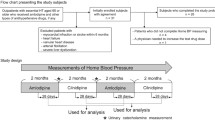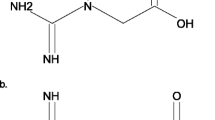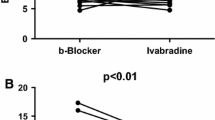Abstract
In man, chronic antihypertensive calcium antagonist treatment improves cardiac function and reduces plasma ANF concentrations. Physical exercise increases cardiac workload and plasma ANF levels. In the present study, we investigated the effects of acute administration of the dihydropyridine calcium antagonist BAY t 7207 (BAY) during bicycle exercise on plasma ANF and plasma cyclic GMP levels, on mean arterial pressure (MAP), heart rate (HR), and on natriuresis and urinary urodilatin excretion.
In a randomized, double-blind placebo controlled cross-over trial, 8 patients (age 56.8±2.5 y) with documented coronary artery disease and mildly impaired left ventricular function (EF 50.0±1.3%), received oral BAY (20 mg) or placebo. Forty-five minutes after medication, patients underwent a standardised exercise bicycle test in the supine position (6 min 25 W, 6 min 50 W).
Before exercise, MAP was lower after BAY (88.8±4.1 mmHg) than after placebo (95.7±3.5 mmHg; p+0.024), and HR was higher after BAY (76.8±3.5 bpm) than after placebo (69.5±3.6 bpm; p+0.049). Plasma ANF tended to be higher after BAY (31.2±5.6 pg/ml) than after placebo (26.7±5.0 pg/ml), and plasma cGMP was not different (BAY 3.4±0.3, placebo 3.8±0.3 pmol/ml). During exercise, the relative increases in HR (+43%) and MAP (+17%) were identical after BAY and placebo. In contrast, ANF levels during exercise increased by 130±28% after placebo but only by 36±11% after BAY (p+0.011). In parallel, plasma cyclic GMP increased by 61±13% after placebo and by 20±8% after BAY (p+0.013). At the end of exercise, the BAY-induced reduction in plasma cyclic GMP reflected the reduction in diastolic arterial pressure (r+0.717; p+0.045). Compared to placebo, BAY treatment increased the fractional excretion rate of sodium from 0.46±0.11 to 0.90±0.22% (p+0.016), without relation to urinary urodilatin excretion.
Thus, the calcium antagonist BAY t 7207 attenuated the exercise-induced increase in plasma ANF and cyclic GMP probably due to its vasodilator effect. The relationship between blood pressure and the ANF system during exercise, which parallels findings during chronic antihypertensive treatment, may open a perspective for early evaluation of long-term therapy with calcium channel blockers.
Similar content being viewed by others
References
Burnett JCJ, Osborn MJ, Hammill SC, Heublein DM (1989) The role of frequency of atrial contraction versus atrial pressure in atrial natriuretic peptide release. J Clin Endocrinol Metab 69:881–884
Choong CYP, Roubin GS, Shen WF, Tokuyasu Y, Harris PJ, Kelly DT (1985) Improvement in exercise capacity and associated changes in hemodynamics and left ventricular function after the addition of metoprolol to nifedipine in patients with stable exertional angina. Clin Cardiol 8:213–224
Coruzzi P, Musiari L, Mossini GL, Novarini A (1993) Regulation of sodium excretion in human hypertension: long-term effects of calcium antagonist and angiotensin converting enzyme inhibitor. J Cardiovasc Pharmacol 21:920–925
Doubell AF (1989) The second messenger system(s) mediating the secretion of atrial natriuretic peptide (ANP) from the isolated rat heart during rapid cardiac pacing. Life Sci 45:2193–2200
Drummer C, Fiedler F, Bub A, Kleefeld D, Dimitriades E, Gerzer R, Forssmann WG (1993) Development and application of a urodilatin (CDD/ANP-95–126)-specific radioim-munoassay. Pflugers Arch 423:372–377
Forssmann K, Hock D, Herbst F, Schulz-Knappe P, Talartschik J, Scheler F, Forssmann WG (1986) Isolation and structural analysis of the circulating human cardiodilatin (alpha ANP). Klin Wochenschr 64:1276–1280
Gerzer R, Drummer C (1993) Is the renal natriuretic peptide urodilatin involved in the regulation of natriuresis? J Cardiovasc Pharmacol 22 [Suppl 2]:S86-S87
Haufe MC, Gerzer R, Weil J, Ernst JE, Theisen K (1988) Verapamil impairs secretion of stimulated atrial natriuretic factor in humans. J Am Coll Cardiol 11:1199–1203
Heim JM, Gottmann K, Weil J, Haufe MC, Gerzer R (1988) Is cyclic GMP a clinically useful marker for ANF action? Z Kardiol 77 [Suppl 2]:41–46
Katoh S, Toyama J, Aoyama M, Miyamoto N, Seo H, Matsui N, Kodama I, Yamada K (1990) Mechanisms of atrial natriuretic peptide (ANP) secretion by rat hearts perfused in vitro-Ca2(+)-dependent signal transduction for ANP release by mechanical stretch. Jpn Circ J 54:1283–1294
King KA, Ledsome JR (1990) The effect of tachycardia on right atrial dynamics and plasma atrial natriuretic factor in anaesthetized rabbits. J Physiol (Lond) 422:289–301
King KA, Ledsome JR (1991) Atrial dynamics, atrial natriuretic factor, tachycardia, and blood volume in anesthetized rabbits. Am J Physiol 261:H22–H28
Kiowski W, Erne P, Bertel O, Bolli P, Bühler F (1986) Acute and chronic sympathetic reflex activation and antihypertensive response to nifedipine. J Am Coll Cardiol 7:344–348
LaPointe MC, Deschepper CF, Wu JP, Gardner DG (1990) Extracellular calcium regulates expression of the gene for atrial natriuretic factor. Hypertension 15:20–28
Lehnert H, Schmitz H, Preuss K, Kustner E, Krause U, Beyer J (1993) Effects of nitrendipine on blood pressure, reninangiotensin-system and atrial natriuretic peptide in hypertensive type I diabetic patients. Horm Metab Res 25:24–28
Müller-Esch G, Schüßler S, Peinke V, Drummer C, Gerzer R, Kentsch M (1993) Clinical evidence that the renal peptide urodilatin (95–126 ANP), rather than atrial natriuretic peptide (99–126 ANP), is the mediator of natriuresis following atrial distension. Exp Clin Endocrinol 101, [Suppl 1]:29 (abstract)
Phillips RA, Ardeljan M, Shimabukuro S, Goldman ME, Garbowit DL, Eison HB, Krakoff LR (1991) Normalization of left ventricular mass and associated changes in neurohormones and atrial natriuretic peptide after 1 year of sustained nifedipine therapy for severe hypertension. J Am Coll Cardiol 17:1595–1602
Rappelli A, Dessi-Fulgheri P, Bandiera F, Di-Noto G (1989) Increase of plasma atrial natriuretic peptide levels after sublingual administration of nifedipine in essentially hypertensive patients. Int J Cardiol 25 [Suppl 1]:S25-S28
Rappelli A, Dessi-Fulgheri P, Madeddu P, Glorioso N (1987) Studies on the natriuretic effect of nifedipine in hypertensive patients: increase in levels of plasma atrial natriuretic factor without participation of the renal kallikrein-kinin system. J Hypertens [Suppl 5]:S61-S65
Riddervold F, Smiseth OA, Hall C, Groves G, Risoe C (1991) Rate-induced increase in plasma atrial natriuretic factor can occur independently of changes in atrial wall stretch. Am J Physiol 260:H1953-H1958
Sei CA, Glembotski CC (1990) Calcium dependence of phenyle-phrine-, endothelin-, and potassium chloride-stimulated atrial natriuretic factor secretion from long term primary neonatal rat atrial cardiocytes. J Biol Chem 265:7166–7172
Shamiss A, Peleg E, Rosenthal T, Ezra D (1993) The role of atrial natriuretic peptide in the diuretic effect of Ca2+ entry blockers. Eur J Pharmacol 233:113–117
Tanaka H, Shindo M, Gutkowska J, Kinoshita A, Urata H, Ikeda M, Arakawa K (1986) Effect of acute exercise on plasma immunoreactive-atrial natriuretic factor. Life Sci 39:1685–1693
Walsh KP, Williams TD, Spiteri C, Pitts E, Lightman SL, Sutton R (1988) Role of atrial pressure and rate in release of atrial natriuretic peptide. Am J Physiol 254:R607-R610
Zachariah PK, Burnett JCJ, Ritter SG, Strong CG (1987) Atrial natriuretic peptide in human essential hypertension. Mayo Clin Proc 62:782–786
Author information
Authors and Affiliations
Rights and permissions
About this article
Cite this article
Kentsch, M., Müller-Esch, G., Otter, W. et al. The dihydropyridine calcium channel blocker BAY t 7207 attenuates the exercise induced increase in plasma ANF and cyclic GMP in patients with mildly impaired left ventricular function. Eur J Clin Pharmacol 49, 177–182 (1995). https://doi.org/10.1007/BF00192377
Received:
Accepted:
Issue Date:
DOI: https://doi.org/10.1007/BF00192377




